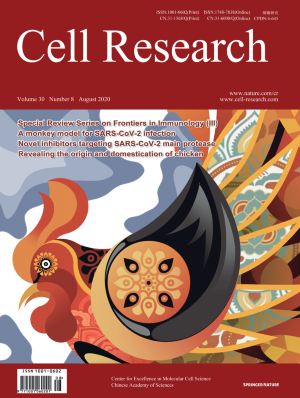Volume 30 Issue 8, August 2020: 693-701
ORIGINAL ARTICLES
863 genomes reveal the origin and domestication of chicken
Ming-Shan Wang1,2,3,6 , Mukesh Thakur1,3 , Min-Sheng Peng1,2,4 , Yu Jiang5 , Laurent Alain François Frantz1,6,7 , Ming Li5 , Jin-Jin Zhang1,2 , Sheng Wang1,2 , Joris Peters8,9 , Newton Otieno Otecko1,2 , Chatmongkon Suwannapoom10 , Xing Guo11 , Zhu-Qing Zheng5 , Ali Esmailizadeh1,12 , Nalini Yasoda Hirimuthugoda1,13 , Hidayat Ashari14,15 , Sri Suladari14 , Moch Syamsul Arifin Zein14 , Szilvia Kusza16 , Saeed Sohrabi12 , Hamed Kharrati-Koopaee12,17 , Quan-Kuan Shen1,2 , Lin Zeng1,2 , Min-Min Yang1,2 , Ya-Jiang Wu1,18 , Xing-Yan Yang1,18 , Xue-Mei Lu1,2,4 , Xin-Zheng Jia19,20 , Qing-Hua Nie21 , Susan Joy Lamont20 , Emiliano Lasagna22 , Simone Ceccobelli22 , Humpita Gamaralalage Thilini Nisanka Gunwardana13 , Thilina Madusanka Senasige13 , Shao-Hong Feng23 , Jing-Fang Si24 , Hao Zhang24 , Jie-Qiong Jin1,25 , Ming-Li Li1,2 , Yan-Hu Liu1,2 , Hong-Man Chen1,2 , Cheng Ma1,2 , Shan-Shan Dai1,2 , Abul Kashem Fazlul Haque Bhuiyan26 , Muhammad Sajjad Khan27 , Gamamada Liyanage Lalanie Pradeepa Silva28 , Thi-Thuy Le29 , Okeyo Ally Mwai19 , Mohamed Nawaz Mohamed Ibrahim19 , Megan Supple30 , Beth Shapiro30,31 , Olivier Hanotte32,33 , Guojie Zhang1,2,34,35 , Greger Larson6 , Jian-Lin Han15,19,* , Dong-Dong Wu1,2,4,* , Ya-Ping Zhang1,2,4,18,*
1State Key Laboratory of Genetic Resources and Evolution, Yunnan Laboratory of Molecular Biology of Domestic Animals, Kunming Institute of Zoology, Chinese Academy of Sciences, Kunming, Yunnan, China
2Kunming College of Life Science, University of Chinese Academy of Sciences, Kunming, Yunnan, China
3Zoological Survey of India, New Alipore, Kolkata, West Bengal, India
4Center for Excellence in Animal Evolution and Genetics, Chinese Academy of Sciences, Kunming, Yunnan, China
5Key Laboratory of Animal Genetics, Breeding and Reproduction of Shaanxi Province, College of Animal Science and Technology, Northwest A&F University, Yangling, Shaanxi, China
6The Palaeogenomics and Bio-Archaeology Research Network, Research Laboratory for Archaeology and History of Art, University of Oxford, Oxford, UK
7School of Biological and Chemical Sciences, Queen Mary University of London, London, UK
8ArchaeoBioCenter and Department of Veterinary Sciences, Institute of Palaeoanatomy, Domestication Research and the History of Veterinary Medicine, LMU Munich, Munich, Germany
9SNSB, Bavarian State Collection of Anthropology and Palaeoanatomy, Munich, Germany
10School of Agriculture and Natural Resources, University of Phayao, Phayao, Thailand
11College of Animal Science and Technology, Anhui Agricultural University, Hefei, Anhui, China
12Department of Animal Science, Shahid Bahonar University of Kerman, Kerman, Iran
13Faculty of Agriculture, University of Ruhuna, Matara, Sri Lanka
14Museum Zoologicum Bogoriense, Research Center for Biology, Indonesian Institute of Science (LIPI), Cibinong, Indonesia
15CAAS-ILRI Joint Laboratory on Livestock and Forage Genetic Resources, Institute of Animal Science, Chinese Academy of Agricultural Sciences (CAAS), Beijing, China
16Institute of Animal Husbandry, Biotechnology and Nature Conservation, University of Debrecen, Debrecen, Hungary
17Institute of Biotechnology, School of Agriculture, Shiraz University, Shiraz, Iran
18State Key Laboratory for Conservation and Utilization of Bioresource, Yunnan University, Kunming, Yunnan, China
19Livestock Genetics Program, International Livestock Research Institute (ILRI), Nairobi, Kenya
20Department of Animal Science, Iowa State University, Ames, IA, USA
21College of Animal Science, South China Agricultural University, Guangzhou, Guangdong, China
22Dipartimento di Scienze Agrarie, Alimentarie Ambientali, University of Perugia, Perugia, Italy
23BGI-Shenzhen, Beishan Industrial Zone, Shenzhen, Guangdong, China
24Laboratory of Animal Genetics, Breeding and Reproduction, Ministry of Agriculture of China, National Engineering Laboratory for Animal Breeding, College of Animal Science and Technology, China Agricultural University, Beijing, China
25Southeast Asia Biodiversity Research Institute, Chinese Academy of Sciences (CAS-SEABRI), Yezin, Myanmar
26Bangladesh Agricultural University, Mymennsingh, Bangladesh
27University of Agriculture Faisalabad, Faisalabad, Pakistan
28Department of Animal Science, University of Peradeniya, Peradeniya, Sri Lanka
29National Institute of Animal Husbandry, Hanoi, Vietnam
30Department of Ecology and Evolutionary Biology, University of California, Santa Cruz, Santa Cruz, CA, USA
31Howard Hughes Medical Institute, University of California, Santa Cruz, Santa Cruz, CA, USA
32Cells, Organisms and Molecular Genetics, School of Life Sciences, University of Nottingham, Nottingham, UK
33Livestock Genetics Program, International Livestock Research Institute (ILRI), Addis Ababa, Ethiopia
34Department of Biology, Centre for Social Evolution, University of Copenhagen, Copenhagen, Denmark
35China National Genebank, BGI-Shenzhen, Shenzhen, Guangdong, China
36Present address: Department of Ecology and Evolutionary Biology, Howard Hughes Medical Institute, University of California, Santa Cruz, Santa Cruz, CA, USA
†These authors contributed equally: Ming-Shan Wang, Mukesh Thakur, Min-Sheng Peng, Yu Jiang, Laurent Alain François Frantz, Ming Li
Correspondence: Jian-Lin Han(h.jianlin@cgiar.org)Dong-Dong Wu(wudongdong@mail.kiz.ac.cn)Ya-Ping Zhang(zhangyp@mail.kiz.ac.cn)
Despite the substantial role that chickens have played in human societies across the world, both the geographic and temporal origins of their domestication remain controversial. To address this issue, we analyzed 863 genomes from a worldwide sampling of chickens and representatives of all four species of wild jungle fowl and each of the five subspecies of red jungle fowl (RJF). Our study suggests that domestic chickens were initially derived from the RJF subspecies Gallus gallus spadiceus whose present-day distribution is predominantly in southwestern China, northern Thailand and Myanmar. Following their domestication, chickens were translocated across Southeast and South Asia where they interbred locally with both RJF subspecies and other jungle fowl species. In addition, our results show that the White Leghorn chicken breed possesses a mosaic of divergent ancestries inherited from other subspecies of RJF. Despite the strong episodic gene flow from geographically divergent lineages of jungle fowls, our analyses show that domestic chickens undergo genetic adaptations that underlie their unique behavioral, morphological and reproductive traits. Our study provides novel insights into the evolutionary history of domestic chickens and a valuable resource to facilitate ongoing genetic and functional investigations of the world’s most numerous domestic animal.
https://doi.org/10.1038/s41422-020-0349-y
FULL TEXT | PDF
Browse 1171


